The best way to tighten flabby arms after 50 is through consistent resistance training that strengthens the biceps, triceps, and shoulders. This type of training helps rebuild age-related muscle loss, improves arm firmness, and supports better posture.
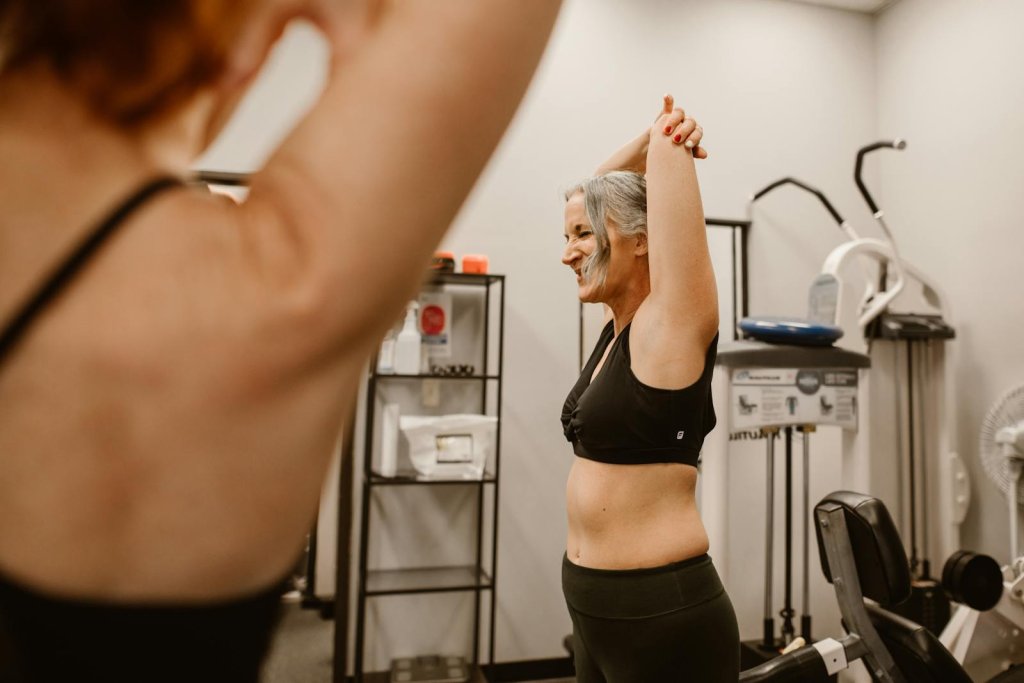
As women age, natural muscle decline, hormonal changes, and reduced activity levels can make the upper arms appear softer. The good news: safe, simple exercises can gradually tone the arms without heavy weights or complex equipment.
In this guide, you’ll learn why flabby arms happen, how often to train, the 10 best exercises for women over 50, safety tips, and a sample weekly routine.
What Causes Flabby Arms After 50?
Understanding the root causes helps you approach arm training safely and realistically:
- Age-related muscle loss (sarcopenia): Muscle mass naturally declines after age 40 and accelerates after 50 if not trained.
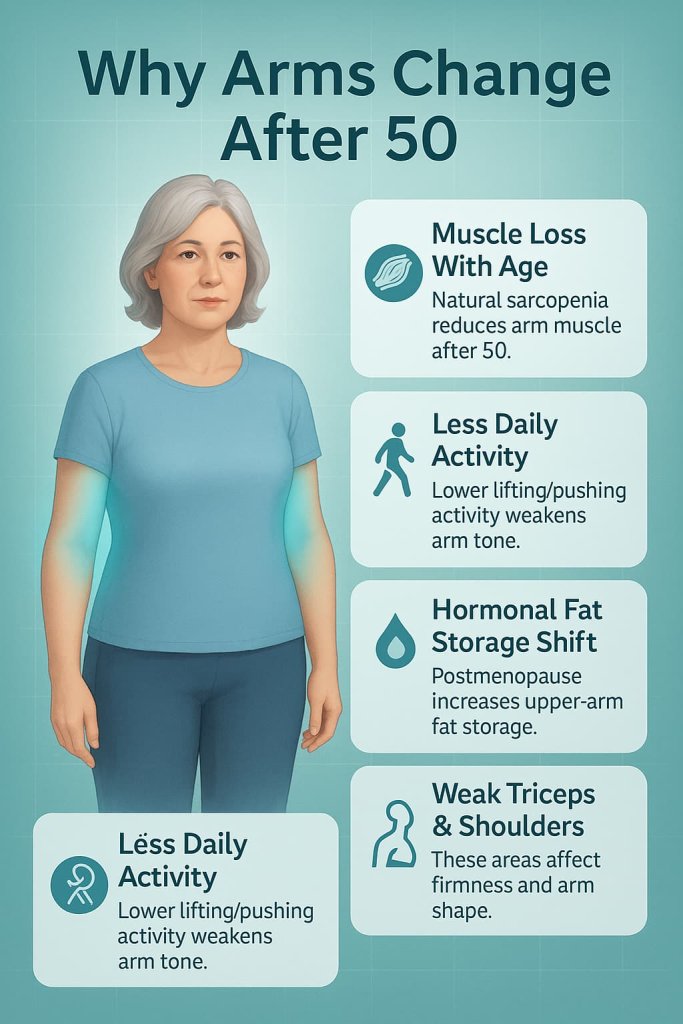
- Reduced physical activity: Fewer daily lifting, pushing, and pulling movements reduce arm strength and tone.
- Higher body fat around the upper arms: Hormonal changes during and after menopause increase fat storage patterns.
- Weak triceps and shoulders: These areas affect upper-arm firmness and posture.
- Poor posture: Rounded shoulders and forward head position make arms look less toned.
Resistance training directly addresses all these factors by building muscle, increasing metabolism, and improving upper-body shape.
Benefits of Flabby Arm Exercises for Women Over 50
Consistent training provides meaningful improvements:
- Builds and maintains lean muscle
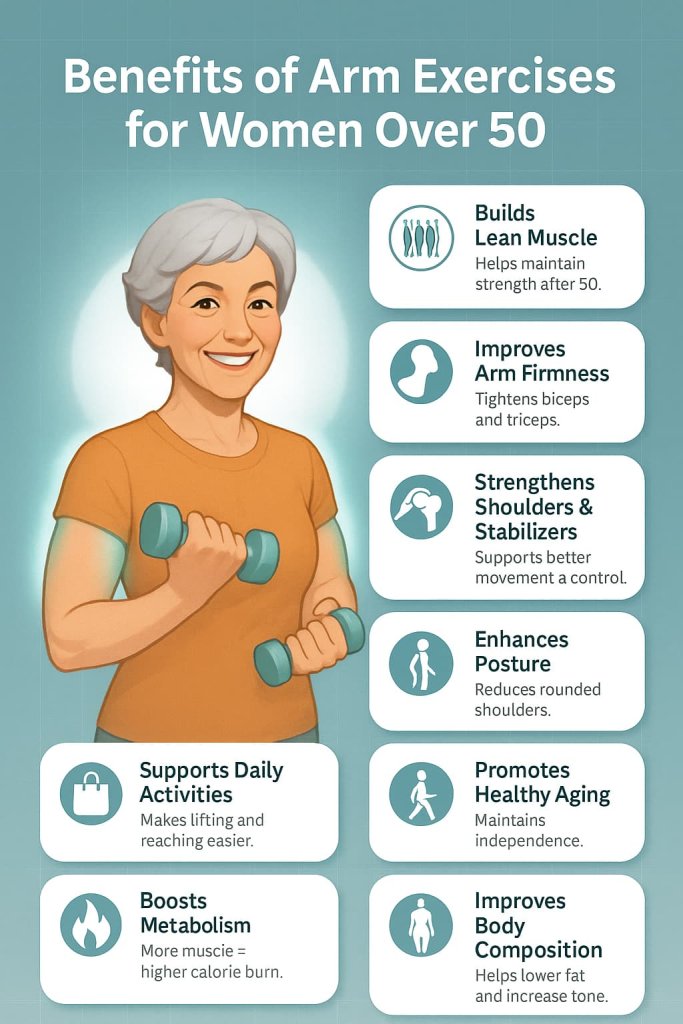
- Increases arm firmness and definition
- Strengthens biceps, triceps, and shoulder stabilizers
- Supports better posture and reduces rounding of shoulders
- Helps with daily tasks like lifting, carrying, and reaching
- Supports healthy aging and functional independence
- Boosts metabolism by increasing muscle mass
- Helps improve overall body composition when combined with general activity
Warm-Up Before You Begin
A quick warm-up increases blood flow, loosens stiff joints, and helps prevent strain—especially important for women over 50.
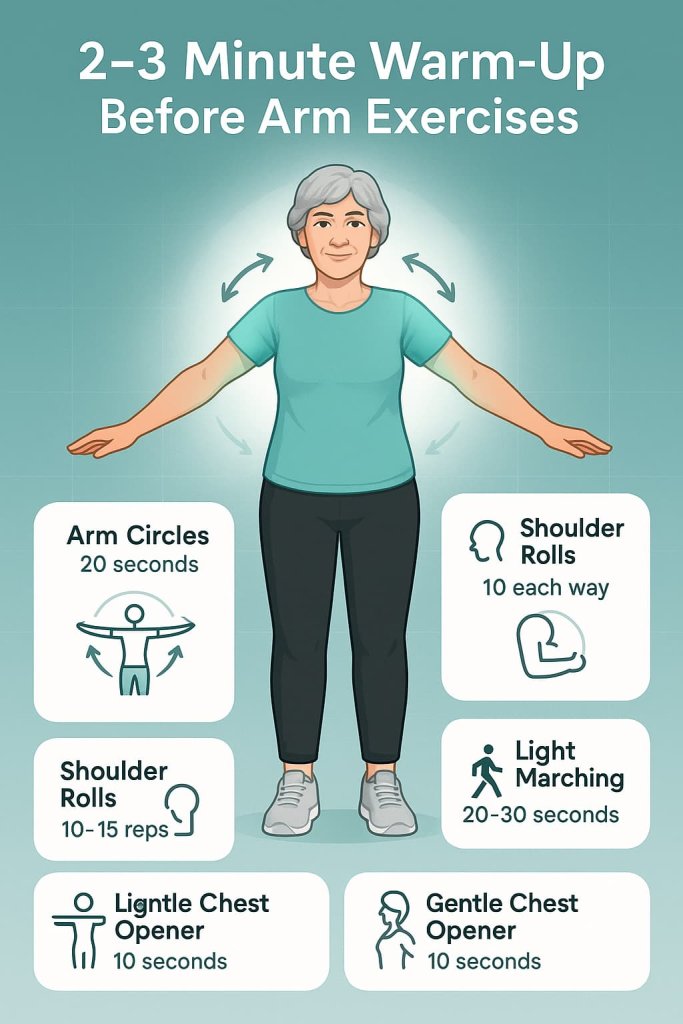
2–3 Minute Warm-Up:
- Arm circles – 20 seconds
- Shoulder rolls – 10 each way
- Elbow flex/extend – 10–15 reps
- Light marching – 20–30 seconds
- Gentle chest opener – 10 seconds
10 Best Flabby Arm Exercises for Women Over 50
The following exercises are safe, beginner-friendly, and designed to strengthen the biceps, triceps, and shoulders—areas most responsible for upper-arm firmness. Each movement uses simple equipment and focuses on smooth, controlled technique to help women over 50 tighten and tone their arms effectively.
1. Wall Push-Ups
Why it works
A gentle, joint-friendly push-up variation that strengthens the chest, shoulders, and triceps without stressing the wrists or lower back. Ideal for beginners or anyone with limited upper-body strength. It improves pushing strength and upper-body endurance, helping with daily tasks like getting up from chairs or carrying items.
Muscles worked
Chest, triceps, front shoulders, core.
How to do it
- Stand facing a wall, arms straight, hands slightly wider than shoulder-width.
- Step your feet back until your body forms a diagonal line.
- Bend your elbows and lower your chest toward the wall.
- Pause briefly, keeping your core engaged.
- Push back to the starting position with control.
- Perform 8–12 slow, steady reps.
Trainer Tip
Keep elbows at a 45-degree angle and avoid shrugging your shoulders upward.
2. Incline Counter Push-Ups
Why it works
This variation increases difficulty compared to wall push-ups, targeting the triceps more deeply while still supporting the wrists and shoulders. The inclined angle reduces pressure on joints and builds upper-body strength safely.
Muscles worked
Triceps, chest, shoulders, core.
How to do it
- Place your hands on a sturdy countertop, table, or bench.
- Walk your feet back to create a straight, diagonal body line.
- Lower your chest toward the counter by bending your elbows.
- Keep your core tight as you push back up.
- Perform 8–12 controlled reps.
Trainer Tip
The lower the surface, the harder the exercise—adjust height as your strength improves.
3. Seated or Standing Biceps Curls
Why it works
A classic isolation exercise that strengthens the biceps and enhances upper-arm shape. Controlled curls help build functional pulling strength for lifting groceries or carrying items.
Muscles worked
Biceps, forearms.
How to do it
- Hold dumbbells or resistance bands at your sides with palms forward.
- Keep elbows close to your torso.
- Slowly bend your elbows to lift the weights.
- Lower them back down with control.
- Perform 8–12 reps.
Trainer Tip
Avoid swinging—use a slow tempo and keep elbows stable for best results.
4. Hammer Curls
Why it works
A wrist-friendly biceps exercise that also targets the brachialis, a deep muscle that adds thickness to the upper arm. Great for women with elbow discomfort during traditional curls.
Muscles worked
Biceps, brachialis, forearms.
How to do it
- Hold weights with palms facing inward.
- Curl the weights upward while keeping your elbows still.
- Lower slowly with control.
- Perform 8–12 reps.
Trainer Tip
Choose a light-to-moderate weight to maintain smooth, pain-free movement.
5. Triceps Kickbacks
Why it works
This exercise directly targets the back of the arms—the area most commonly associated with “flabby arms.” It isolates the triceps and helps tighten and firm the upper arm.
Muscles worked
Triceps.
How to do it
- Place one hand on a chair or bench for support.
- Hold a dumbbell in the opposite hand.
- Lean forward slightly with a flat back.
- Keep your upper arm still as you extend your forearm straight back.
- Return slowly to the starting position.
- Perform 8–12 reps per arm.
Trainer Tip
Only your forearm should move—keep your upper arm locked in place to maximize triceps engagement.
6. Seated Overhead Triceps Extensions
Why it works
Strengthens the long head of the triceps, which plays a major role in upper-arm firmness. The seated position offers extra stability for beginners.
Muscles worked
Triceps (long head).
How to do it
- Sit tall with feet flat.
- Hold one dumbbell with both hands and lift it overhead.
- Bend your elbows to lower the weight behind your head.
- Straighten your arms to return to the starting position.
- Perform 8–12 slow reps.
Trainer Tip
If your shoulders feel tight, reduce the weight or try a resistance band instead.
7. Band Pull-Aparts
Why it works
Strengthens the rear shoulders and upper back—key muscles that improve posture and help the arms look more toned. It counteracts rounded shoulders commonly seen with age.
Muscles worked
Rear deltoids, upper back, rotator cuff.
How to do it
- Hold a resistance band at chest height with arms straight.
- Pull the band apart by opening your arms wide.
- Pause and squeeze your shoulder blades together.
- Return with control.
- Perform 10–15 reps.
Trainer Tip
Keep shoulders down and relaxed—avoid lifting them toward your ears.
8. Resistance Band Rows
Why it works
Strengthens the upper back, rear shoulders, and biceps. Improving back strength enhances posture, which naturally makes the arms look firmer and more lifted.
Muscles worked
Back, rear shoulders, biceps.
How to do it
- Anchor the band at chest height.
- Hold the handles or ends with arms extended.
- Pull the band toward your ribs while squeezing your shoulder blades.
- Slowly return to start.
- Perform 8–12 reps.
Trainer Tip
Think “pull back and down” with your shoulder blades to avoid rounding your shoulders.
9. Lateral Raises
Why it works
A shaping exercise that builds the outer shoulders, improving overall arm definition. Great for enhancing the silhouette of the upper arm.
Muscles worked
Side shoulders (lateral deltoids).
How to do it
- Hold light dumbbells at your sides.
- Lift arms out to shoulder height with a slight bend in the elbows.
- Lower with control.
- Perform 8–12 reps.
Trainer Tip
Start extremely light—1–3 lb is enough for most beginners to maintain good form.
10. Arm Circles
Why it works
Improves shoulder mobility, increases blood flow, and builds endurance in the deltoids. This is an excellent warm-up and toning exercise for women over 50.
Muscles worked
Shoulders, rotator cuff, upper back.
How to do it
- Extend arms out to the sides at shoulder height.
- Make small forward circles for 20–30 seconds.
- Reverse and circle backward for another 20–30 seconds.
Trainer Tip
Keep movements small and controlled. Avoid lifting arms higher than shoulder level.
How Often Should Women Over 50 Train Arms?
For best results, follow major guidelines:
- 2–3 days per week of arm-focused resistance training
- 1–3 sets per exercise for beginners; up to 3–4 sets with experience
- 8–12 reps per set with slow, controlled tempo
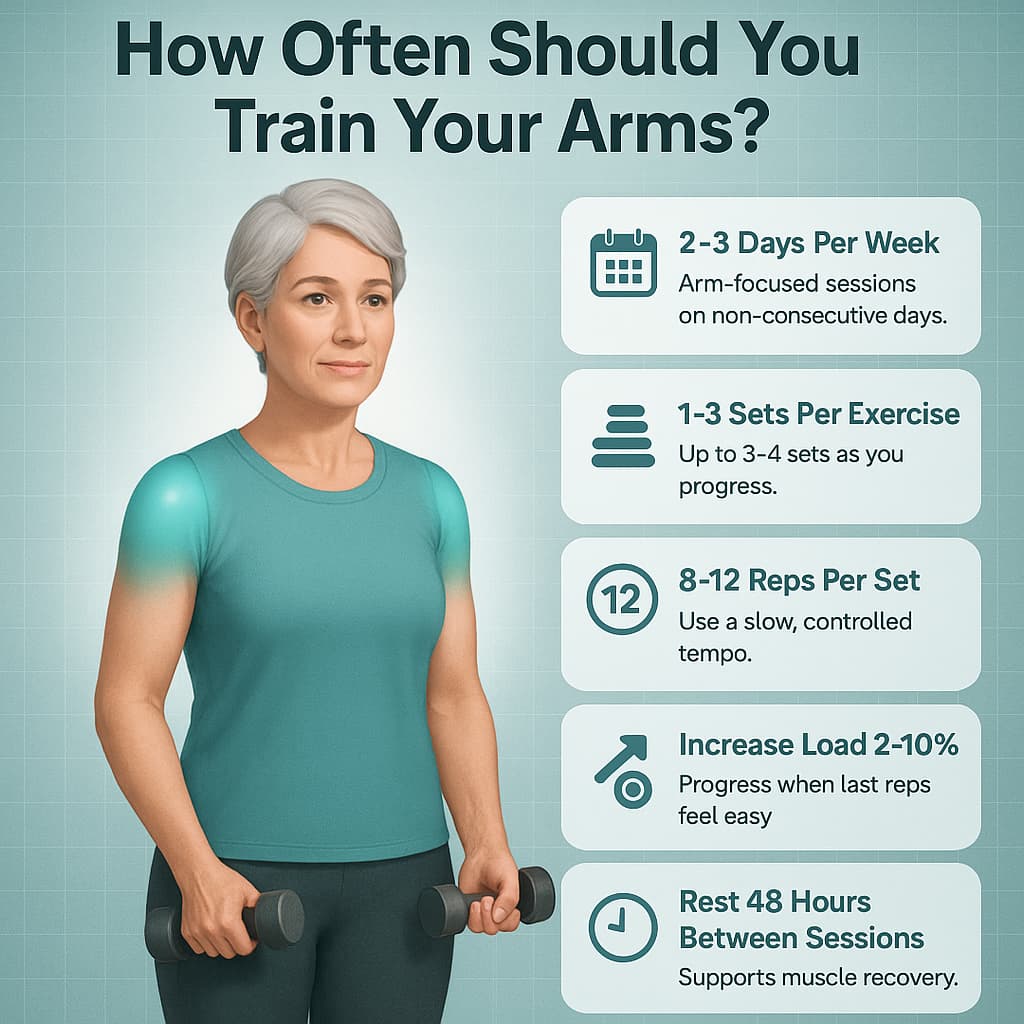
- Increase load 2–10% when the last 1–2 reps feel easy
- Rest 48 hours between sessions targeting the same muscles
- Warm up 2–3 minutes before starting
This schedule helps build strength while supporting joint health and recovery.
Sample Weekly Arm-Toning Routine for Women Over 50
A simple, joint-friendly 2-day schedule:
Day 1 (Strength)
- Wall Push-Ups – 2 sets
- Biceps Curls – 2–3 sets
- Triceps Kickbacks – 2 sets
- Band Rows – 2–3 sets
- Arm Circles – 30 seconds
Day 2 (Toning & Posture)
- Incline Counter Push-Ups – 2 sets
- Hammer Curls – 2 sets
- Overhead Triceps Extensions – 2 sets
- Band Pull-Aparts – 2–3 sets
- Lateral Raises – 2 sets
Repeat weekly with at least 48 hours rest between sessions.
Safety Tips for Women Over 50
Follow these guidelines for safe, effective training:
- Consult a healthcare professional if you have heart disease, uncontrolled blood pressure, recent surgery, or severe joint issues.
- Start with very light dumbbells (1–3 kg / 2–5 lb) or bands.
- Warm up for 2–3 minutes before training.
- Maintain slow, controlled form.
- Avoid any exercise that causes sharp pain.
- Progress gradually—do not rush weights or reps.
- Stay hydrated and take breaks as needed.
Who Should Avoid These Exercises or Be Careful
Most women over 50 can safely do these movements, but some should use caution or consult a healthcare professional first.
Be careful or get medical advice if you have:
- Uncontrolled high blood pressure or heart issues
- Shoulder, elbow, or wrist injuries
- Severe arthritis or recent surgery
- Osteoporosis with fracture history
Stop if:
You feel sharp pain, numbness, dizziness, or chest discomfort.
FAQ: Flabby Arm Exercises for Women Over 50
1. Can you really tighten flabby arms after 50?
Yes. You can significantly firm the arms by building muscle through resistance training.
2. How long does it take to see results?
Most women notice improved firmness and strength within 6–12 weeks with consistent training.
3. Do I need heavy weights?
No. Light dumbbells (2–5 lb) or resistance bands are enough for beginners.
4. Will I get bulky arms?
No. Women over 50 typically gain lean, toned muscle—not bulk.
5. Can I do these exercises daily?
It’s better to train arms 2–3 days per week with rest between sessions.
6. Can arm exercises reduce fat in one area?
No—spot reduction isn’t possible. But stronger triceps and shoulders make the arms look firmer.
7. Are these exercises safe for beginners?
Yes—especially when starting with light resistance and focusing on form.
Conclusion
Tightening flabby arms after 50 is absolutely possible with safe, consistent resistance training. By focusing on simple movements that target the biceps, triceps, and shoulders, you can rebuild lost muscle, improve firmness, and maintain strength for daily life. Start slow, stay consistent, and track your progress week by week for the best results.
Ready to begin? Start with 2–3 sessions per week and gradually build the strength and arm tone you want.
References
- González-Gálvez N, et al. Resistance training effects on physical fitness and body composition in healthy postmenopausal women. Menopause. 2024.
https://pubmed.ncbi.nlm.nih.gov/38353251/ - Kim S-W, Park H-Y, Jung W-S, Lim K. Effects of 24 weeks of resistance exercise training in obese older women. International Journal of Environmental Research and Public Health. 2022.
https://www.mdpi.com/1660-4601/19/21/14554 - Khalafi M, et al. Effects of exercise training on body composition in postmenopausal women: A systematic review and meta-analysis. Frontiers in Endocrinology. 2023.
https://www.frontiersin.org/articles/10.3389/fendo.2023.1183765 - Isenmann E, et al. Resistance training alters body composition in middle-aged women. BMC Women’s Health. 2023.
https://bmcwomenshealth.biomedcentral.com/articles/10.1186/s12905-023-02671-y - Fragala MS, et al. Resistance Training for Older Adults: Position Statement From the National Strength and Conditioning Association. Journal of Strength and Conditioning Research. 2019.
https://www.nsca.com/contentassets/2a4112fb355a4a48853bbafbe070fb8e/resistance_training_for_older_adults__position.1.pdf - Chodzko-Zajko WJ, et al. Exercise and Physical Activity for Older Adults: American College of Sports Medicine Position Stand. Medicine & Science in Sports & Exercise. 2009.
https://www.bewegenismedicijn.nl/files/downloads/acsm_position_stand_exercise_and_physical_activity_for_older_adults.pdf - U.S. Department of Health and Human Services. Physical Activity Guidelines for Americans, 2nd edition. 2018.
https://health.gov/sites/default/files/2019-09/Physical_Activity_Guidelines_2nd_edition.pdf
